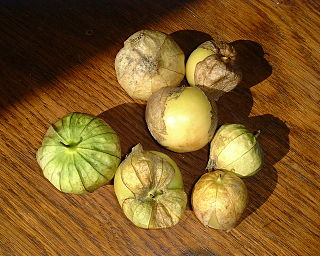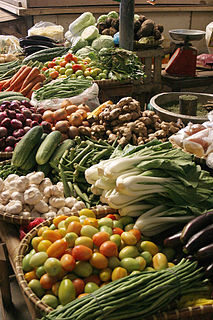
The potato is a starchy tuber of the plant Solanum tuberosum and is a root vegetable native to the Americas. The plant is a perennial in the nightshade family Solanaceae.

Alfalfa, also called lucerne, is a perennial flowering plant in the legume family Fabaceae. It is cultivated as an important forage crop in many countries around the world. It is used for grazing, hay, and silage, as well as a green manure and cover crop. The name alfalfa is used in North America. The name lucerne is the more commonly used name in the United Kingdom, South Africa, Australia, and New Zealand. The plant superficially resembles clover, especially while young, when trifoliate leaves comprising round leaflets predominate. Later in maturity, leaflets are elongated. It has clusters of small purple flowers followed by fruits spiralled in 2 to 3 turns containing 10–20 seeds. Alfalfa is native to warmer temperate climates. It has been cultivated as livestock fodder since at least the era of the ancient Greeks and Romans.

Ketchup or catsup is a type of table condiment with a sweet and tangy flavor. The unmodified term ("ketchup") now typically refers to tomato ketchup, although original recipes used egg whites, mushrooms, oysters, grapes, mussels, or walnuts, among other ingredients.

The tomatillo, also known as the Mexican husk tomato, is a plant of the nightshade family bearing small, spherical and green or green-purple fruit of the same name. Tomatillos originated in Mexico and were cultivated in the pre-Columbian era. A staple of Mexican cuisine, they are eaten raw and cooked in a variety of dishes, particularly salsa verde.

Peanut oil, also known as groundnut oil or arachis oil, is a vegetable oil derived from peanuts. The oil usually has a mild or neutral flavor but, if made with roasted peanuts, has a stronger peanut flavor and aroma. It is often used in American, Chinese, Indian, African and Southeast Asian cuisine, both for general cooking, and in the case of roasted oil, for added flavor.

Pomology is a branch of botany that studies fruit and its cultivation. The term fruticulture—introduced from Romance languages —is also used.

Solanum quitoense, known as naranjilla in Ecuador, Costa Rica, and Panama and as lulo in Colombia, is a tropical perennial plant from northwestern South America. The specific name for this species of nightshade means "from Quito."

The Roma tomato or Roma is a plum tomato popularly used both for canning and producing tomato paste because of its slender and firm nature. Commonly found in supermarkets in some countries, Roma tomatoes are also known as Italian tomatoes or Italian plum tomatoes.

An orange is a fruit of various citrus species in the family Rutaceae ; it primarily refers to Citrus × sinensis, which is also called sweet orange, to distinguish it from the related Citrus × aurantium, referred to as bitter orange. The sweet orange reproduces asexually ; varieties of sweet orange arise through mutations.

Vegetables are parts of plants that are consumed by humans or other animals as food. The original meaning is still commonly used and is applied to plants collectively to refer to all edible plant matter, including the flowers, fruits, stems, leaves, roots, and seeds. An alternate definition of the term is applied somewhat arbitrarily, often by culinary and cultural tradition. It may exclude foods derived from some plants that are fruits, flowers, nuts, and cereal grains, but include savoury fruits such as tomatoes and courgettes, flowers such as broccoli, and seeds such as pulses.

Solanum pimpinellifolium, commonly known as the currant tomato or pimp, is a wild species of tomato native to Ecuador and Peru but naturalized elsewhere, such as the Galápagos Islands. Its small fruits are edible, and it is commonly grown in gardens as an heirloom tomato, although it is considered to be wild rather than domesticated as is the commonly cultivated tomato species Solanum lycopersicum. Its genome was sequenced in 2012.

African blue basil is a hybrid basil variety, a cross between camphor basil and dark opal basil. It is one of a few types of basil that are perennial. African blue basil plants are sterile, unable to produce seeds of their own, and can only be propagated by cuttings.

San Marzano tomato is a variety of plum tomato.

The tomato is the edible berry of the plant Solanum lycopersicum, commonly known as a tomato plant. The species originated in western South America and Central America. The Mexican Nahuatl word tomatl gave rise to the Spanish word tomate, from which the English word tomato derived. Its domestication and use as a cultivated food may have originated with the indigenous peoples of Mexico. The Aztecs used tomatoes in their cooking at the time of the Spanish conquest of the Aztec Empire, and after the Spanish encountered the tomato for the first time after their contact with the Aztecs, they brought the plant to Europe, in a widespread transfer of plants known as the Columbian exchange. From there, the tomato was introduced to other parts of the European-colonized world during the 16th century.

Carya tomentosa, is a tree in the Juglandaceae or walnut family. The most abundant of the hickories, common in the eastern half of the US, it is long lived, sometimes reaching the age of 500 years. A straight-growing hickory, a high percentage of its wood is used for products where strength, hardness, and flexibility are needed. The wood makes excellent fuel wood, as well. The leaves turn yellow in Autumn.

Eliza Tibbets was among early American settlers and founders of Riverside, California; she was an activist in Washington, D.C., for progressive social causes, including freedmen's rights and universal suffrage before going to the West Coast. A spiritualist, she led seances in Riverside. She became known for successfully growing the first two hybrid Washington navel orange trees in California.
The United States is the largest grower of commercial crops that have been genetically engineered in the world, but not without domestic and international opposition.
The U.S. National Plant Germplasm System (NPGS) is a network of institutions and agencies led by the Agricultural Research Service (ARS) of the U.S. Department of Agriculture in the effort to conserve and facilitate the use of the genetic diversity of agriculturally important plants and their wild relatives.

The Celebrity tomato cultivar is a hybrid (biology) that produces long fruit-bearing stems holding 20 or more very plump, robust tomatoes. Fruits weigh approximately 8 oz., and are 4 inches across. Plants need caging or staking, and produce fruit throughout the growing season. The celebrity tomato is a cultivar of the species Solanum lycopersicum. It is a crossbreed of the common tomato that is widely used for various culinary purposes. This tomato is of great size and is known to be resistant to most tomato diseases such as Fusarium wilt, Verticillium wilt, Tobacco mosaic virus and Root-knot nematode due to its hybrid nature. Celebrity tomatoes are highly adaptive to harsh environments and can grow in a wide range of places including dry, humid and wet regions. They are resistant to cracking and splitting which usually occurs when there is an excess of water and sugar movement in the fruits. Therefore, causing the tomato skin to grow at a slower rate compared to the expansion of the fruit. They can survive in harsh uneven rainfall. However, they are highly susceptible to colder environments and are at a higher risk of dying in regions with short growing seasons. The plants can grow up to 5 feet in height with bright red medium-sized fruits. The plants are generally very thick and grow in clusters. The tomato fruits are mostly used in the making of various salsas, salads, juices and canned food.

The U.S. Department of Agriculture's Pomological Watercolor Collection is an archive of some 7,500 botanical watercolors created for the USDA between the years 1886 and 1942 by around five dozen artists. Housed by the United States National Agricultural Library, it is a unique resource documenting existing fruit and nut cultivars, new introductions, and specimens discovered by USDA's plant explorers, representing 38 plant families in all. It has been called "one of the world's most unusual holdings of late 19th and early 20th century American botanical illustrations".


















